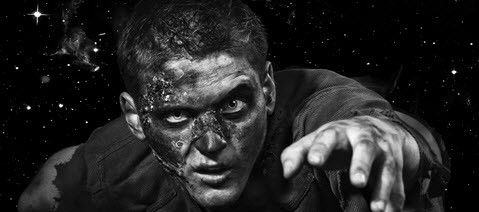After vicious hand-to-hand combat in the airlock, the hero shoves the villain out into the cold vacuum of space, where cosmic radiation immediately burns him to a crisp. Hurrah! Justice!
While this makes for good cinema, it’s not entirely accurate. So what really happens if you’re ejected into outer space without a helmet or spacesuit? Knowing the real physics will help you make decisions on how to animate death in outer space.

You’d die within about 10 minutes, and a very uncomfortable 10 minutes it would be. The cause would be just one thing: oxygen deprivation.
Not to say you wouldn’t have other problems. Our bodies have evolved to work with a certain internal and external air pressure, which you know about if you’ve ever had an earache after flying. When you get in the airplane, the air inside your head’s many canals is at ground-level pressure. The air pressure at airplane heights is much lower than at ground level, so unless you take some steps to equalize the two pressures, your eardrums naturally stretch to push outward toward the low pressure.
Anyone who’s experienced this will tell you how painful this is. In outer space, where there’s no air pressure at all, your eardrums would pop right away. While this might seem unpleasant, it wouldn’t kill you.
Shortly afterward, in less than a minute, you’d pass out due to oxygen deprivation. This is lucky for you because the next few minutes are about to get a whole lot worse.
Lack of internal pressure would cause your soft tissues to bruise, and your saliva, tears, and blood would boil (turn to gas) but not from heat. Recall that liquids boil at lower temperatures when air pressure is lower, so lowering pressure is just as effective as heat for making something boil. All this bruising and boiling would cause blood to ooze out of your nose and ears, and the vapor from your boiling blood would expand, causing your skin to bloat. While this would certainly freak you out if you were conscious enough to feel it happening, it wouldn’t kill you.

Your skin, normally exposed only to light filtered through Earth’s atmosphere, might also get a fast, severe sunburn from starlight or cosmic rays. But while this might be uncomfortable, again it wouldn’t kill you, at least not anytime soon.
Right around this time, about 10 minutes in, you’d die from oxygen deprivation. If you could somehow be rescued before then, everything that’s happened so far could potentially be cured. Your body would still be fairly warm, as it takes a lot of time for heat to dissipate when there’s no air for the heat to leach out to.
So a little boiling, bruising, bloating, bleeding, and sunburn. Not very dramatic, unless taken to extremes. In fact, the few documented cases of exposure (by astronauts and pilots using faulty suits or equipment) tell us that the human body won’t explode, vomit organs, pop its eyeballs, immediately burn, freeze, boil, or do any number of sensational things sometimes depicted in the movies. But because we’ll never see or experience it firsthand, and because we love to see the villain die a horrible death, we’re happy to temporarily forget these facts and enjoy a filmmaker’s imaginative rendition of Death by Outer Space.
You can learn more about depicting outer space with VFX in Chapter 10 of Physics for Animators. Also there’s a great article at IFL Science that describes some of the more gruesome details of the process.
